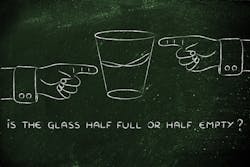I will admit that one of my own pet peeves is hiring a glass half-empty employee, as I believe there is a direct correlation to their performance when compared to another employee who sees things from a more positive point of view. I tend to be an optimistic person and that’s how I approach life—so I automatically have a negative opinion about those that pause, mull things over to uncover any possible risks overlooked by those (like me) that always sell sunshine. I prefer to hire and work with those that adapt to one of my favorite mantras, “find the good.”
But that’s just me and I could be dead wrong.
These two very different employees are good for an organization and especially an IT organization. Why? Employees that view the glass half-full tend to view an existing process or product completely different from their Debbie Downer counterparts. Their unfettered optimism can sometimes be oversold in the way they evaluate a process, a methodology or an IT project. Their mind is focused on always having a positive outcome, which can be both good and bad. They drink the Kool-Aid of optimism always focused on the upside, and always overlooking potential pitfalls. They don’t have a balanced approach and their can-do attitude can create challenges unless they are questioned by others that see things differently.
Glass half-empty employees can be more important to an organization, as their methodology is to look for problems. The way they are wired is at the complete opposite end of the spectrum, and they dig deeper to find the hidden issues that were dismissed by their cheery co-workers. Their DNA requires them to look for unseen problems and they automatically assume that they exist—and they set out to find them. The half-empty employees are critical to the IT organization because their actions continually push innovation and continual improvement challenging the status quo. That’s a good thing.
As a person that spends most of my time evaluating talent, my team and I are hired to find the best talent available based on the needs of a client organization, for whatever role they are trying to fill. It’s a disservice to a client to form an early opinion about a candidate just because of the way they think and process information.
I’m of the belief that many of my counterparts do exactly that. When a search professional (internally or externally) makes an early determination, you could be missing out on hiring outstanding talent. It’s our job to match skills, experience, education and other attributes employers need in their organization. It’s not our role to recommend or shortlist people based on their half-full or half-empty approach to the way they conduct themselves at work. In fact, we fail to do our job if we let our own personal pet peeves interfere with the way we evaluate candidates—regardless of the role. Our clients can determine the candidate’s cultural fit and ultimately determine if they are a good fit or not. Again, that’s not our responsibility since they know their culture intimately.
Having talent with diverse skills and different ways to approach a role is much better overall. That means just because the person on the short list of candidates has a different viewpoint than we do—or the hiring manager does—is never a reason to take them out of consideration to make a hiring decision. The workforce is already changing and the candidate pool is getting tighter each month. Being influenced by our own pet peeves could spell trouble in hiring great people if we allow ourselves to be influenced by the way we evaluate talent with our own biased thinking.
Having a full workforce of both glass half-full and half-empty employees is much better than having lots of unfilled positions in your IT organization because of the way you hire talent.


